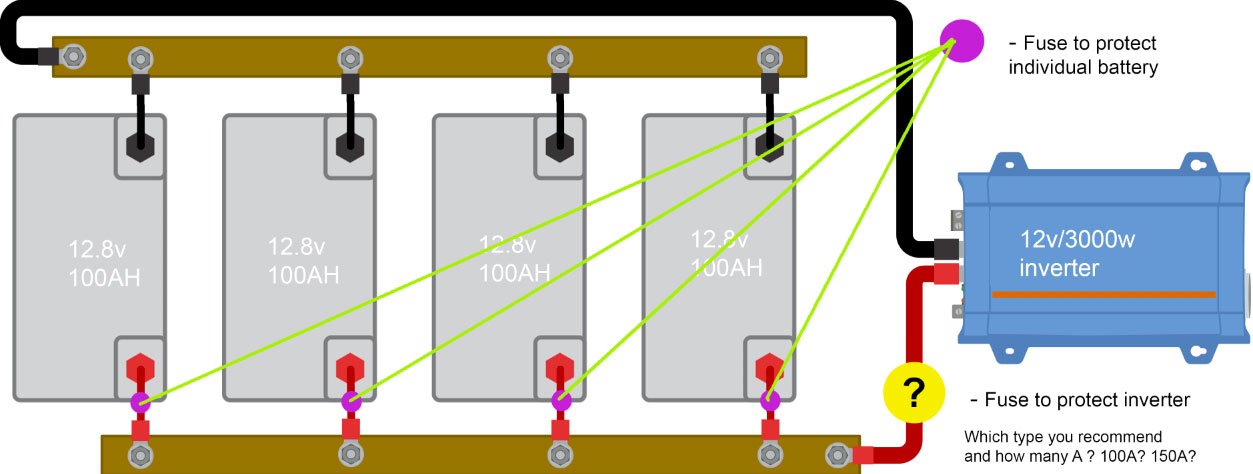Documentation on the site
https://www.victronenergy.com/media/pg/The_Wiring_Unlimited_book/en/dc-wiring.html
part 4.6. Fuses and circuit breakers
Please show some light for the question about how to calculate the fuse(s) below related to the protection for the inverter from the batteries connection side.
In documentation there is advice to use Fuses placed in the positive cable.
For example we have the system like on the image battery_bank_01_fuse_2.png (attached).
1) Inverter 12v 3200w nominal continuous power (6400 surge power) -> 220v out
2) 12.8 LiFePO4 100AH (+bms) x 4 = battery bank (connected in parallel)
3) cable (Cu) connection length not more then 1m and cable cross-section 50 mm2 (thinking no need 70 mm2 but can use in case of need)
Question 1:
How to calculate the main fuse placed in the positive cable connection batteries bank to the inverter
(to protect the inverter from the batteries bank connection side (short circuit, etc) ) ?
With max load of the inverter we have:
3200w / 12v ~= 267A
6400w / 12v ~= 534A (surge)
Should we place the DC fuse 300A (12v) or what is better ?
/connection cable 50 mm2 (Cu)/ (if I need 70 mm2 cable (Cu) - will use it)
Question 2:
How to calculate the fuse placed in the positive cable for every individual battery before it connects to the general(+) busbar (5mmx20mm (Cu)) ?
(this fuse is protection of the individual battery in the batteries bank (short circuit, etc), right ? )
Should we place the DC fuse 150A (12v) or what is better ?
/connection cable 50 mm2 (Cu)/ (if I need 70 mm2 cable (Cu) - will use it)?
--------------------
Thank you for your time and advice.
- Home
- Anonymous
- Sign in
- Create
- Spaces
- Grafana
- Node-Red
- Unsupported topics
- Questions & Answers
- Modifications
- Communauté francophone
- Deutschsprachiger Bereich
- Preguntas en Español
- Explore
- Topics
- Questions
- Ideas
- Articles
- Badges
question
How to calculate the fuses to protect the inverter and individual battery in bank?
Fuses protect wires.
Wires should be sized to handle the continuous current. Surge is generally regarded as being so short, it's not considered in sizing.
Fuses should be 1.25X the current rating of the wire. This also helps give the fuse/breaker additional tolerance for surges.
3200W/12.8V/.85 = 294A (0.85 is for conversion efficiency)
The wires from the bus bars to the inverter need to be rated to handle 294A continuously. You'd need a 368A fuse (round up to 400A). Class T preferred due to the low resistance of LFP batteries.
The individual batteries are rated for 100A, so 100A wire and 125A fuse.
Fuses should be 1.25X the current rating of the wire.
What is the soure of that recommendation? At least in Germany this would not comply with VDE regulations. Of course, in other jurisdiction other rules may apply. Are you sure that it isn't the other way around?
I.e. first calculate the load (as you did), then choose a fuse which is higher than the maximum expected current (such that the fuse does not blow unintentional) and then choose a wire whose rating is 1.25 times *above* the rating of the fuse such that the wire is able to carry the current even if the fuse blows a little bit later than specified.
Related Resources
question details
41 People are following this question.
